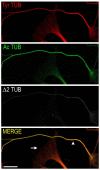Ubiquitin Proteasome System and Microtubules Are Master Regulators of Central and Peripheral Nervous System Axon Degeneration
- PMID: 35456037
- PMCID: PMC9033047
- DOI: 10.3390/cells11081358
Ubiquitin Proteasome System and Microtubules Are Master Regulators of Central and Peripheral Nervous System Axon Degeneration
Abstract
Axonal degeneration is an active process that differs from neuronal death, and it is the hallmark of many disorders affecting the central and peripheral nervous system. Starting from the analyses of Wallerian degeneration, the simplest experimental model, here we describe how the long projecting neuronal populations affected in Parkinson's disease and chemotherapy-induced peripheral neuropathies share commonalities in the mechanisms and molecular players driving the earliest phase of axon degeneration. Indeed, both dopaminergic and sensory neurons are particularly susceptible to alterations of microtubules and axonal transport as well as to dysfunctions of the ubiquitin proteasome system and protein quality control. Finally, we report an updated review on current knowledge of key molecules able to modulate these targets, blocking the on-going axonal degeneration and inducing neuronal regeneration. These molecules might represent good candidates for disease-modifying treatment, which might expand the window of intervention improving patients' quality of life.
Keywords: Parkinson’s disease; axon regeneration; chemotherapy-induced peripheral neuropathies; dying back; microtubules; ubiquitin proteasome system.
Conflict of interest statement
The authors declare no conflict of interest.
Figures



